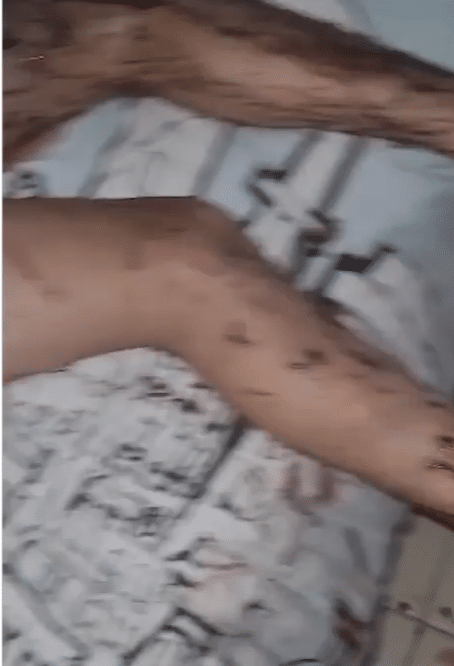Investigators build legal case documenting ‘systematic and unprecedented cruelty’ with echoes of Adolf Eichmann trial
NIR OZ, Israel—Eitan Cunio heard the militants enter his house and watched as gasoline seeped under the door of the safe room where he sheltered with his wife and two children.
His 1-year-old daughter was crying as the family’s home in Kibbutz Nir Oz was set alight and smoke began entering the room. Cunio put wet sheets at the bottom of the door and told his family they would stay inside rather than be killed or kidnapped. If we die, we die together at home, he said.
Before passing out, Cunio sent a tearful voice note to a friend in his community: “Brother, it’s horrible. We are going to die.”
Months have passed since the October day Israelis call Black Sabbath, when Hamas-led militants rampaged into Israel from Gaza, an attack that officials say killed some 1,200 people and included acts of torture, mutilation and sexual violence. Israeli investigators are now using some 200,000 photographs and videos and 2,000 witness testimonies to reconstruct what happened, with an eye toward building a legal case against those responsible that would meet international standards and provide a definitive historical accounting of the Oct. 7 attack.
[The Wall Street Journal Report continues]
Israel’s investigation is expected to yield a trial that would be the country’s most significant since the early 1960s, when Israel captured, tried and hanged former Nazi official Adolf Eichmann for his central role in the Holocaust.
“The state of Israel has never before dealt with crimes and an investigation on this scale,” said Roi Sheindorf, former deputy to the attorney general. “This will be one of the most important trials to take place in Israel.”
The Israeli police are examining testimonies from captured militants, footage from cameras obtained from them, social media, and vehicle dashboards and security cameras throughout southern Israel, as well as materials seized in Gaza.
One challenge for the investigation, legal analysts say, is that the collection of forensic evidence was limited in the aftermath of Oct. 7, while the Israeli military was engaged in combat in the area for days after the attack.
More than 21,000 Palestinians have since died in airstrikes and fighting between the Israeli military and Hamas, most of them women and children, according to Palestinian health authorities. The number doesn’t distinguish between civilians and combatants.
An accompanying goal of Israel’s investigation could also be preserving history, much like the Eichmann trial laid out Nazi Germany’s Final Solution to the world and began a process for witnesses to come forward en masse to speak of the horrors they experienced.
[The Wall Street Journal Report continues]
Militants posted videos of some of the killings and kidnappings on victims’ social media pages, where friends and family watched. When militants forced their way into Noam Elyakim’s home, they shot him in the leg, then took his wife’s phone and livestreamed the family being taken hostage on Facebook. In another instance, Shay Shimoni saw a video posted by militants of her 75-year-old mother dead in a pool of blood. The Journal viewed both videos, which are no longer online.
New details about sexual violence also are emerging. Investigators initially found no rape survivors, but at least three women have since come forward to the Ministry of Welfare saying they experienced sexual violence, said Ayelet Razin Bet Or, a former government official helping with the investigation.
One witness saw militants gang rape a woman and then cut off her breast, according to police testimony viewed by the Journal. First responders said they saw signs of sexual violence, including women found naked or with their underwear pulled down or tops removed.
The Journal saw images taken by a first responder of a naked woman with a knife and three nails in the crotch area, women whose clothing was partially or entirely removed and women with blood from the crotch area. In another image provided by the first responder, a woman’s breast was almost entirely sliced off. Her shirt was ripped away and she had a knife wound in the neck. In two other photos a naked man was found gagged and shot and one photo showed a man’s eyeball had been removed.
Shari Mendes, 62, a reservist in the Israeli army who helped identify bodies after Oct. 7, said people were shot in the head so many times they were disfigured.
First victims
Three miles east from the Gaza border in Kfar Aza, a community of 950, militants on paragliders landed in a sports field where later that day residents planned an annual kite-flying festival.
The festival, which over the years became a peace gesture to Gazans, was organized by Aviv Kutz, 53, his wife Livnat, 49, and their three teenage children. They hoped that Gazans would see the kites and fly their own in return, according to Aviv’s father, Benny Kutz.
The family had eaten dinner together the night before, a rare luxury as the children lived away from home. Rotem, 18, was serving in the army and Yonatan, 16, and Yiftach, 14, were at boarding school.
[The Wall Street Journal Report continues]
Around 7 a.m., Gil Taasa and his two sons ran from his house to a bomb shelter yards from the front door, according to a video camera capturing their movements, which has since been added to a video compilation shown by Israel to world leaders and journalists.
Seconds later, a militant threw a grenade inside.
Taasa told his sons not to be scared and jumped on top of the grenade to shield them. He died, his limp body slumping out of the entrance to the shelter, according to the video.
Koren and Shay ran back into the house, where a militant entered the kitchen.
“Daddy!” said one of the boys in disbelief.
“Daddy’s dead, Shay,” Koren said, according to a video from inside the kitchen.
“I know I saw,” Shay said.
“I think we are going to die,” his brother appears to reply, according to video footage inside their father’s home which was included in the video that Israel created.
Shay was badly injured during the grenade explosion and couldn’t see out of one eye. Koren attempted to care for his brother’s wounds with a wet towel and used Google Translate to try to communicate with two militants.
He pleaded for them to kill him instead of his brother. The militants decided to leave, telling the boys to stay put, adding: “If you move, we will kill you.”
[The Wall Street Journal Report continues]
Sexual assault
At the festival, Hamas militants began to sexually assault women, witnesses told the police. Fighters took women back to Gaza with them, and in one example, paraded the half-naked body of a female festival goer in the back of a pickup, according to a widely shared video on Telegram.
In a recording of a phone call that morning, militants driving in Israel cheered as one of them talked about raping a woman.
“I am going to f— her, I am going to f— her,” he told another person on the line, according to an unverified recording shared with the Journal by Israeli officials.
At Eitan Cunio’s community Nir Oz, the heat and smoke in his shelter had become so intense, he and his wife began to say goodbye to their two daughters, Ofri, 4 and Stav, a year and nine months. They all passed out.
At about 1 p.m., Eitan Cunio regained consciousness as a friend phoned to say he was coming to get them.
[The Wall Street Journal Report continues]
Five members of Eitan Cunio’s family were released in last month’s exchange for Palestinian prisoners, but his twin brother and his younger brother and girlfriend are still being held, according to Israeli authorities.
‘Open up’
In Netiv HaAsara, Sabine Taasa heard a knock on her door: “Open up, it’s me, Koren.”
Standing at the door were her youngest sons covered in blood and shrapnel wounds. They had run from their father’s house and were on the verge of collapse, according to a video Sabine later took inside her shelter. Her youngest son’s eye was full of blood and he had a large wound on the back of his leg.
At least three members of the community’s emergency-response team of volunteers soon arrived. Before evacuating, she ran to Gil Taasa’s house where she found his body in a pool of blood. Flies rested on his face.
She cried and hugged him, before collapsing herself and being carried away.
[The Wall Street Journal Report continues]
Sabine Taasa provided testimony to the police investigation and now wants justice. Four attackers were captured at Netiv HaAsara, and she is hopeful she will be able to confront Gil Taasa’s killers.
“I want to stand in front of them and identify them with my son,” she said. “That is Koren’s wish.”
View this Wall Street Journal Report from December 31st

